Chapter 2
Investing in the Essential Tools
In This Chapter
Cookware you really need
Bakeware basics
Small appliances, big help
Kitchen gadgets — useful or useless?
Owning kitchen equipment is like having a car. When you first get your driver’s license, a dented 10-year-old Honda Civic is nirvana. But as you become a more experienced driver, you start dreaming of something better, maybe a Lexus. When you enter the wonderful world of cooking, you can do fine with just a few basic tools — the ride may not be as luxurious, but you’ll get to the prom on time. You can always upgrade later.
This chapter is all about the kitchen equipment you really need, and how to use it correctly. Learning how to use kitchen equipment properly is time well spent.
If you are getting started or are on a tight budget, we suggest some essential tools. As you become more proficient, you may want to expand your repertoire — and, for that reason, we let you know about more luxurious equipment, too.
Note that the one type of equipment we don’t cover in detail here is knives. That’s because they’re so important that we gave them their own chapter: Chapter 4.
Collecting Your Cookware Basics
Here is our short list of bare-bones-all-I-can-spend-now kitchen equipment. (You can find more detailed descriptions of some of these items later in this chapter.) See Chapter 1 for information on appliances. This is our list of pots, pans, and other tools no home cook should be without:
10-inch chef’s knife: You can perform more than 80 percent of all cutting and slicing chores with this knife.
9- to 12-inch serrated bread knife: Invaluable for cutting slices of fresh bread without squishing the loaf, and also for slicing other delicate foods like fresh tomatoes.
Paring knife: For peeling, coring, and carving radish roses and miniature replicas of the Eiffel Tower from rutabagas. (Or just for peeling and coring.)
10-inch nonstick skillet: Your go-to pan for sautéing or frying just about anything.
3-quart saucepan: For cooking vegetables, rice, soups, sauces, and small quantities of pasta.
10-quart stockpot with lid: For making stocks or large quantities of soup, pasta, and vegetables. You’ll be surprised by how often you use this pot.
Heavy-duty roasting pan: For cooking everything from beef brisket to your Thanksgiving turkey. Roasting pans have high sides to keep in all those juices you can use to make gravy.
Liquid and dry measuring cups and measuring spoons: So you don’t botch recipes by using too much or too little of something.
Strainer: Essential for straining sauces and soups, rinsing pasta, or cleaning and draining lettuce and fruit.
Meat thermometer: Why guess?
Vegetable peeler, heatproof rubber spatula, and a few wooden spoons: Don’t go off the deep end buying little kitchen gizmos; these tools are all you need to get started.
Picking Pots and Pans
Have you ever wondered what the difference is between a pot and a pan? If it has two opposite-set handles and a lid, it’s classified as a pot. Pans have one long handle and come with or without lids. This section gives a rundown of important pots and pans and how to evaluate them, including the must-haves listed in the previous section and lots of other types of fancy pots and pans you don’t need but may decide to acquire anyway.
Doing some comparison shopping
Pots and pans come in all kinds of materials, from aluminum with a nonstick coating to heavy-duty stainless steel to expensive copper to muscle-building cast iron coated with enamel. The more you cook, the more uses you’ll find for different kinds of pots and pans, and the more you’ll develop your own tastes and preferences for different types of pots and pans and different materials.
Here are some things to keep in mind when buying cookware:
Consider going the nonstick route. Nonstick coatings are the best aid to novice cooks since grocery stores started selling spaghetti sauce in jars. If you do a lot of fat-free and lowfat cooking, you want to invest in a high quality nonstick skillet, which can drastically reduce the amount of butter or oil you need during cooking. Nonstick pans don’t brown foods as well as regular pans do, but they’re easier to clean, and the convenience may be worth it.
In recent years, nonstick pans have improved tremendously, and the linings last longer than before — as long as you don’t use metal utensils with them. A few new varieties even work with metal utensils and have lifetime guarantees. So many brands exist that keeping track of them all is difficult.
Nonstick aluminum is light, durable, and a great conductor of heat. Look in restaurant supply stores where you can buy a nonstick 10-inch sauté pan for as little as $15. It won’t last as long as its pricier cousins (after two or three years the nonstick coating tends to wear out), but the price makes it easy to replace.
If you decide to invest more money in longer-lasting pieces, consider your choice of materials. Copper (lined with stainless steel or tin) provides the best heat control of all metals. That control is the secret of well-textured sauces. Stainless steel with copper or aluminum sandwiched in the base works very well, too, and is less expensive than the all-copper variety.
Think twice about purchasing whole sets, even if they’re on sale, unless you can use every piece. Sets are limited to one type of material and one style, whereas you may be better off with various styles and materials — for example, a nonstick skillet, a cast iron stockpot, and a stainless steel saucepan.
Grasp the handle of the pan in the store. It should sit comfortably in your hand. Ask yourself whether having a heat-resistant handle is important, or whether you will always remember to grab the handle with a potholder. Also consider whether the handle is ovenproof. Some recipes, such as frittatas, require both stove time and oven time. Look for a pan that can do it all.
Don’t assume that the higher the price tag, the better the choice for you. Want to know a secret? Restaurant cooks don’t always use expensive equipment. They do, however, insist on quality. No loose handles or spatulas that bend and break! You want a strong pot or pan with a comfortable handle, a thick base, and if nonstick, a durable coating with a guarantee. Restaurant supply stores can be your best source for affordable, high quality cookware. As you get more experienced, you can spend more based on the way you like to cook. For example, you might try stainless steel pots and pans with a copper core for superior heat distribution, which can lead to a better texture in fancy sauces. For now though, just go for quality and the basics as you build your skills.
Buying the essentials
The following list of different kinds of pots and pans is not exhaustive, but it will get you started. These are the pots and pans we think you’ll use the most.
Nonstick skillet or sauté pan
You’ll probably use this skillet all the time, so get a good, heavy-duty one. (See the preceding section for tips on what to buy.) If you prefer, try a heavier and very durable nonstick stainless steel pan. The choice is yours, but nonstick is also easier to clean (although not always made for the dishwasher).
You may wonder, as you browse through your options, why some skillets have rounded, curved sides and some have straight sides. To be more specific, a sauté pan has straight sides, while a frying pan or skillet has rounded sides. You may prefer one or the other. The rounded sides facilitate fast cooking and flipping food around (like when those fancy chefs flip the food into the air by shaking the handle). The curved sides help you turn the food. The straight sides of a sauté pan are better for enclosing liquids like hot oil and broth so they won’t slosh over the sides, and they’re good for braising and stewing. Sauté pans are also more likely to come with lids.
Your skillet or sauté pan (see Figure 2-1) should be at least 10 or 12 inches in diameter and 2 inches deep, which is ideal for sautéing, braising, frying, and making quick sauces.
Figure 2-1: A nonstick skillet or sauté pan helps you cook with very little fat.
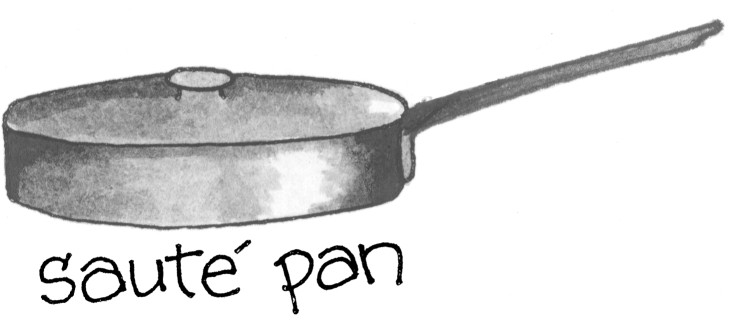
Don’t buy an inexpensive pan (whether nonstick or regular) that is thin and light — it will warp over time. A good skillet should have some heft to it. Purchase pots and pans from a major manufacturer that stands behind its products and will quickly replace or repair damaged goods.
Heavy-gauge cast-iron skillet
The cast-iron skillet, shown in Figure 2-2, has been a standard in American and European kitchens for hundreds of years and still outperforms contemporary cookware in some respects (for example, browning, blackening, and searing). Better yet, a cast-iron skillet is one of the most inexpensive pans you can find, and it will outlast most other skillets as well. Tag sales and antique shops are loaded with them.
Figure 2-2: You use a cast-iron skillet for browning, searing, and more.
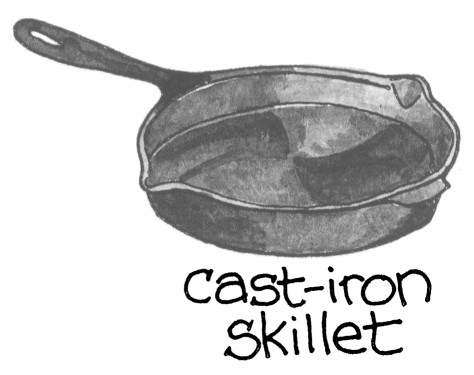
Saucepans
A saucepan can be stainless steel with a copper or aluminum core or a combination of metals. It is an all-around pan used for cooking vegetables, soups, rice, and sauces for pasta and other dishes (see Figure 2-3). You’ll want to own two or maybe three saucepans in different sizes. A 1- to 11⁄2-quart saucepan is perfect for melting small quantities of butter or chocolate or for warming milk. A medium 2- to 3-quart saucepan is essential for making sauces. And saucepans that are 4 quarts or larger are suitable for making soups, steaming vegetables, or boiling a moderate amount of pasta or rice.
Figure 2-3: You use a saucepan to boil foods and make sauces.
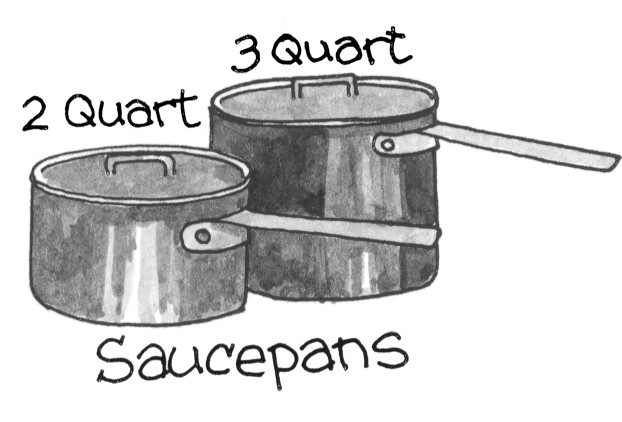
Roasting pans
A well-equipped kitchen should have one oval roasting pan, about 12 inches long, and a large rectangular one, about 14 x 11 inches. An oval roasting pan is suitable for poultry and small roasts; a 14-inch rectangular one can handle two chickens, a large roast, or a load of vegetables from the farmer’s market. The oval one should be enameled cast iron so that it can double as a gratin pan (which we describe later in this section); the rectangular pan can be heavy-gauge aluminum or stainless steel. If you can afford only one roasting pan right now, the covered oval pan is probably the most versatile.
9-x-13-inch baking dish or casserole with lid
Another classic you want to own is the versatile 9-x-13-inch baking dish or covered casserole. Whether made of aluminum, glass, or ceramic, it’s great for making casseroles; roasting winter vegetables; or baking brownies, other bar cookies, and cakes.
Enameled cast-iron stew pot (Dutch oven)
This attractive, all-around stew pot, also called a Dutch oven, is ideal for slow-cooking stews, soups, and all sorts of hearty winter meals (see Figure 2-4). Enamel doesn’t brown food as well as cast iron or plain stainless steel, however. You may want to brown or sear meat in a separate pan before adding it to the Dutch oven. A 4-quart version made by Le Creuset and a similar one from Copco are excellent.
Figure 2-4: Use this stew pot, or Dutch oven, for cooking stews and soups.
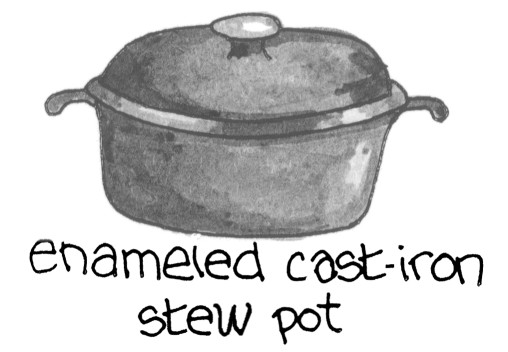
Stockpot
A stockpot is indispensable in any kitchen (see Figure 2-5). It can serve many functions: soup making, braising, steaming, and poaching, to name a few. Look for a tall, narrow, 10- to 14-quart heavy-gauge pot with a tight-fitting lid that can hold a steamer basket. (Inexpensive circular steamers open and close like a fan to fit different sizes of pots and pans.) Heavy aluminum is fine for a stockpot; stainless steel costs twice as much.
Figure 2-5: You make soups and much more in a stockpot.
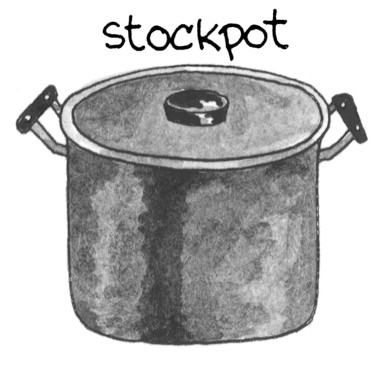
Getting fancy
If you really want to go to town with this pots-and-pans thing, you could probably buy a hundred different ones, each with its own specialized function. But is your kitchen really that big? You can do just about any cooking chore with the pots and pans we’ve listed so far. However, if you want to take it to the next level, you might consider acquiring some of these additional handy pans. They aren’t essential, but they are pretty cool — and some of them even give you the opportunity to spout French to your guests. Who’s not impressed by that?
Rondeau (shallow, straight-sided pot)
A rondeau (pronounced ron-DOE) is great to have on hand when you entertain — and of course you will! A straight-sided pot with two handles and a lid, as shown in Figure 2-6, a 12-inch rondeau (the size we recommend) can hold enough food to serve eight people or more. If you just got a raise (a whopper, that is), consider heavy-gauge copper. It’s so beautiful you may want to set it out on the front lawn when guests are coming for dinner.
Figure 2-6: A rondeau can go from oven to table.
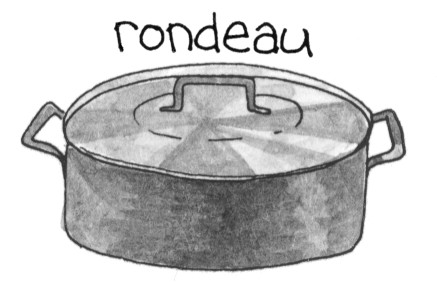
A rondeau has many uses, among them braising, stewing, and browning large quantities of meat, poultry, or fish. Look for brands like All-Clad, Calphalon, Cuisinart, Magnalite, Paderno, and Sitram.
Sauteuse evasée (slope-sided saucepan)
This Gallic mouthful refers to a little pan that is the workhorse of the French kitchen. If you ever splurge on a piece of copper cookware, we recommend a sauteuse evasée (pronounced saw-TOOZ eh-va-SAY), which is 8 to 9 inches in diameter with a volume of about 3 quarts (see Figure 2-7). A sauteuse evasée may be referred to as simply a saucepan, which is its major role. Its sloped sides (evasée refers to the sloped sides) make for easy whisking.
Figure 2-7: You use a sauteuse evasée mainly as a saucepan.

Wok or stir-fry pan
A wok is a large, bowl-shaped pan with a rounded bottom that sits inside a disk that fits over your heat source. Woks work best over a gas flame, but you can still use them if you have an electric stove. In a wok, the very bottom gets super hot, while the sides are cooler, so woks cook meat and vegetables very quickly, leaving vegetables bright and crispy and meats crisp on the outside and tender on the inside. You can cook meat and vegetables in a stir-fry–like technique by using a sauté pan, but for authentically cooked Chinese food, use a wok (or go to a Chinese restaurant).
Pasta pot
A large, 8-quart stainless steel pot fitted with a lid is the perfect size for cooking 1⁄2 to 2 pounds of pasta (or you can use your stockpot instead).
Pancake griddle
This flat, nonstick griddle is well suited for pancakes, grilled cheese sandwiches, bacon, and the like. Of course, you can always use the sauté pan for these chores.
Omelet pan or skillet
An 8- or 10-inch omelet pan, like the one shown in Figure 2-8, is handy to have around if you love your eggs. It’s also handy for sautéing potatoes and other vegetables (see Chapter 6 for more information about sautéing), but of course you can do any of these tasks in your go-to skillet, too.
Figure 2-8: Omelet pans are great for more than just omelets.

Gratin pan
Novice cooks tend to make many one-pot dishes. To give these entrees a delicious finishing touch, often by broiling to crisp the top, you should have a gratin dish, shown in Figure 2-9. Unlike Dutch ovens, gratin dishes are shallow, measure from 10 inches long and up, and do not have a lid. A 12-inch dish can feed six or more people. These pans are ideal for macaroni and cheese, turkey casserole, gratin of potatoes, and many other simple dishes. Some are attractive enough to go from oven to table.
Figure 2-9: A gratin pan is handy for finishing one-pot dishes.

Selecting Tools for Mixing and Baking
Baking requires a wide assortment of pots, pans, bowls, spoons, whisks, and spatulas. While there is some crossover — for instance, you may make lasagna in your 9-x-13-inch baking pan— you’ll probably reserve many of your baking pans, mixing bowls, and stirring equipment for baking because baking tools and equipment are designed specifically for that purpose.
Whether you’re making bread, birthday cake, muffins, or your mother’s killer recipe for homemade brownies, the right baking equipment makes these jobs easier. Here’s what you need.
A kitchen scale: For the home baker, most name-brand scales will do the trick. Get one that can hold 3 or 4 cups of flour. It should be sturdy and feature bright, easy-to-read numbers.
Stainless steel, glass, or ceramic mixing bowls: Mixing bowls are among the most frequently used items in every kitchen. Buy bowls with flat bottoms for good balance in these sizes: 8 quarts, 5 quarts, 3 quarts, and 11⁄2 quarts. Buy them in sets that stack and store easily. You can use these bowls to mix batters for cakes, cookies, or muffins; whip egg whites or whipped cream; let bread dough rise; or even toss salads, whip up sauces and dressings, or store leftovers (if you buy bowls that come with handy plastic lids).
Whisks: Whisks may be made of stainless steel or heat-proof plastic (for use with nonstick cookware). There are several types. A stiffer sauce whisk is about 8 to 10 inches long and perfect for blending sauces, such as béchamel and some cream sauces (see Chapter 14). The larger, rounder balloon whisk is generally 12 to 14 inches long and is better shaped for whipping and incorporating air into egg whites and heavy cream.
Spoons, spatulas, long-handled forks, and tongs: A few wooden spoons of various sizes work best for hand-mixing batters, scraping food bits off the bottom of a simmering casserole, or stirring anything cooking in nonstick cookware. You might also like to have a solid, one-piece stainless steel spoon, about 12 to 15 inches long, for stirring food in larger pots such as stockpots or pasta pots. A slotted, stainless steel spoon removes solid foods from hot liquid — use it to scoop pasta or vegetables from boiling water.
Use a long-handled, stainless steel ladle for doling out soups, sauces, stews, or chili, or for putting pancake batter onto a griddle or into a waffle iron. A heatproof rubber spatula will scrape batter and sauce from bowls or measuring cups. A square-tipped hard plastic turner can flip burgers and other foods cooking on nonstick pans. Metal tongs can turn over tender pieces of meat or fish, and can double as serving items at the table (for salad or spaghetti).
Baking (or cookie) sheet: For baking cookies, biscuits, and breads, a heavy-duty steel or nonstick baking sheet is essential. Some are flat, and some have raised or flared edges to keep butter and juice from spilling into your oven. Baking sheets come in different sizes. Buy two large ones that fit in your oven, leaving a 2-inch margin on all sides to allow an even flow of heat during baking.
Round cake pans: Standard layer cake recipes call for two 8-x-2-inch or 9-x-2-inch pans. Choose anodized or nonstick aluminum.
Square cake pan: For making brownies or gingerbread, you need an 8- or 9-inch square, 2-quart capacity pan. Anodized aluminum and other nonstick materials make removing the brownies easier.
Muffin tins: For baking muffins and cupcakes, most recipes call for a 12-cup or two 6-cup tins of nonstick or heavy-gauge aluminum (or try stoneware or even nonstick silicone). It’s handy to have paper muffin liners on hand too, for recipes (like chocolate cupcakes) that tend to stick. No oil necessary!
Pie pan: A glass or aluminum pan that is 9 inches in diameter suits most standard recipes.
Rolling pin: You don’t need an arsenal of rolling pins like professional pastry chefs have. For home baking, get a two-handled, hardwood or marble rolling pin that is about 15 inches long.
Cooling racks: Cookies and cakes removed from the oven need to cool. Racks allow air to circulate around them. Buy one or two 12- to 14-inch racks.
Silicone pastry mats: These thin mats go on top of your cookie sheet to prevent baked goods from sticking without oil. You can also use them to roll out piecrust and transfer it to your pie plate.
Loaf pan: For baking breads, terrines, and meat loaf, you want a sturdy, 6-cup loaf pan (see Figure 2-10). Look for heavy-duty aluminum or stonewear.
Figure 2-10: You can bake all sorts of foods in a loaf pan.
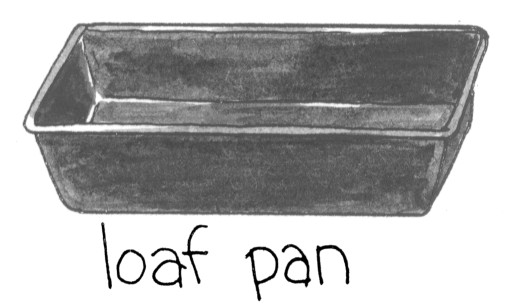
Springform pan: With its hinge-release and detachable bottom, a springform pan easily unmolds cheesecakes, delicate tarts, and cakes with crumb crusts. Get a 9- to 10-inch pan of heavy-gauge aluminum (see Figure 2-11).
Figure 2-11: Use a springform pan to make delicious desserts.

Flour sifter: Not all baking recipes call for sifted flour, but when they do, you need a sifter to aerate the flour and eliminate lumps. A 3-cup sifter is handy, or just use a fine-mesh strainer (see Figure 2-12).
Figure 2-12: You can sift flour by using a strainer.

Pastry brush: To apply glazes and coatings to breads and cakes, use an all-purpose, 11⁄2-inch pastry brush with natural bristles. Pastry brushes are also essential for basting food with pan drippings or sauces. Buy several brushes at a time because they wear out quickly. Clean the brushes with mild dish soap, rinsing thoroughly.
Metal or plastic dry measuring cups: To follow precise recipes, you need a set of dry measuring cups — 1⁄4 cup, 1⁄3 cup, 1⁄2 cup, and 1 cup.
Glass or plastic liquid measuring cup: Get one with a 1-cup and one with a 2-cup capacity, each with a spout for pouring liquids. Four-cup and 8-cup liquid measuring cups come in handy, too.
Metal or plastic measuring spoons: These items are essential for baking. Make sure that the set you purchase comes with 1⁄4 teaspoon, 1⁄2 teaspoon, 1 teaspoon, and 1 tablespoon capacities.
Considering Small Appliances
Toasters and toaster ovens: Everybody needs either a toaster or toaster oven; you probably don’t need both. A toaster oven is more versatile but takes up more counter space. If you use your toaster for, well, toast (or bagels, English muffins, or toaster pastries), just pick one that matches your kitchen décor. If you also want to be able to broil little meals for yourself, the toaster oven is nifty.
Mixers, beaters, and blenders: Mixers, beaters, and blenders are necessary for the home cook. You’ll use these all the time, to mix up cake and cookie batters, blend homemade smoothies or milkshakes, or whip up a fluffy meringue. Here are your choices:
Stand-alone mixers: Strong and durable, these workhorses come with a deep mixing bowl and attachments for whisking, beating, and bread making. Use the beater for batters, the whisk for egg whites and whipped cream, and the dough hook to knead bread dough while you kick back and read a magazine.
Beaters, or hand mixers: These are great for mixing batters, beating egg whites, and making whipped cream. Most hand mixers aren’t sturdy enough to handle bread dough or thick cookie dough.
Blender: The blender is definitely a must-have. Even if you don’t enjoy protein shakes for breakfast or daiquiris on the weekends, you’ll certainly use your blender for many kitchen chores, from chopping a cup of walnuts to making homemade salsa. Blenders and food processors can do many of the same chores, but for beverages and really smooth purées, you can’t beat a blender. Go for the high-quality, heavy-duty blender because it will last for years. A cheap plastic blender can burn out in a few months.
Immersion blender: This appliance, a cross between a hand mixer and a blender, is very popular in professional kitchens. You immerse it in a saucepan of soup or anything else you want to purée in the pan without having to transfer it to a blender.
Slow cookers: Slow cookers (people often refer to any slow cooker as the brand name Crock-Pot) consist of stoneware crocks that sit in heated metal containers. They cook your chicken, roast, rice, veggies, soup, chili, beans, and so on for a long period at a low temperature. Incredibly handy for the time-pressed cook, slow cookers allow you to pop the food in before work in the morning and come home eight to ten hours later to a piping hot meal. Turn to Chapter 16 for more about how to use the slow cooker.
Food processor: A food processor (see Figure 2-13) is a versatile kitchen machine that used to be a luxury but has become a necessity for anybody who cooks a lot. Food processors have steel blades that can whip up pie crust dough in seconds, not to mention sauces, soups, and finely chopped nuts, herbs, or vegetables. Other attachments on the same machine can grate cheese or carrots; slice tomatoes; and chop celery, onions, garlic, or just about anything else. While your blender can do some of these things, it isn’t as versatile. We recommend owning both so you can make great smoothies and flaky pie crust.
Figure 2-13: Food processors can do a wide variety of tasks.

Getting Your Fill of Gizmos and Gadgets
Just when you thought you had everything you need, we’re giving you more! These miscellaneous tools can be useful for all kinds of reasons.
Bulb baster: Using this tool is the most convenient way to coat a roast or chicken with pan juices. A large spoon also works as a basting tool, but a bulb baster is quicker and safer for removing hot grease from the bottom of a roasting pan.
Colander: Buy one made of stainless steel or plastic for draining pasta and rinsing salad greens, vegetables, and berries.
Cutting boards: Use cutting boards to save your counters from sharp knives and hot pots and pans. Plastic or composite boards are easier to clean than wooden ones and can be washed in the dishwasher. Chefs clean their wooden boards with a solution of water and bleach or rub them with lemon juice. Excessive soaking or placing wooden boards in the dishwasher causes them to splinter, warp, and crack.
Kitchen timer: Don’t stand in front of the oven staring at the clock. Set a timer and go watch American Idol. Many ovens and microwaves have built-in kitchen timers, so you may not even need to buy a separate one.
Meat thermometer: Most people can’t tell that a roast has finished cooking by pressing its surface. You can use two types of meat thermometers to check:
An instant-read thermometer, our favorite, has a thin rod that lets you pierce into the roast periodically to test for doneness.
An ovenproof thermometer remains inside the meat or poultry from beginning to end of cooking.
See Figure 2-14 for an illustration of both kinds of meat thermometers.
Figure 2-14: Meat thermometers are essential for determining whether a roast is done.
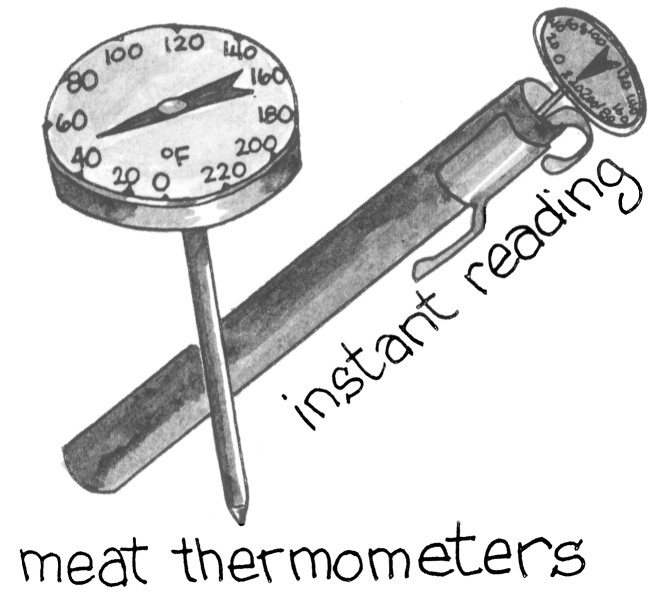
Steamer pots or basket: The conventional steamer model is a pair of pots, the top one having a perforated bottom and a lid. You can also buy bamboo steamers or little metal steamer baskets that fit inside saucepans.
Following are more handy utensils to have around your kitchen:
Citrus juicer
Lemon and cheese grater
Multipurpose kitchen shears
Oven thermometer
Pepper mill
Pie server
Potato masher
Salad spinner
Shrimp deveiner
Vegetable peeler
